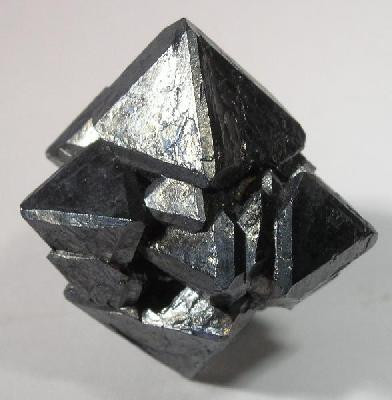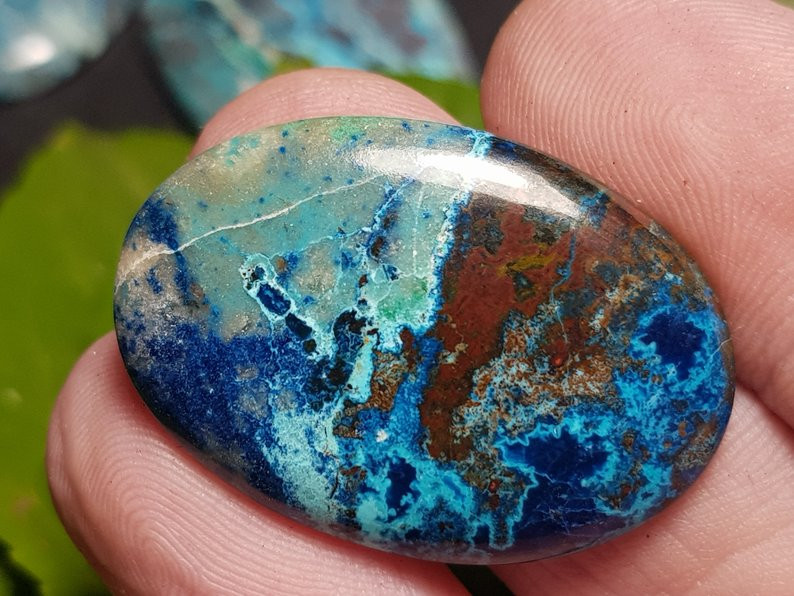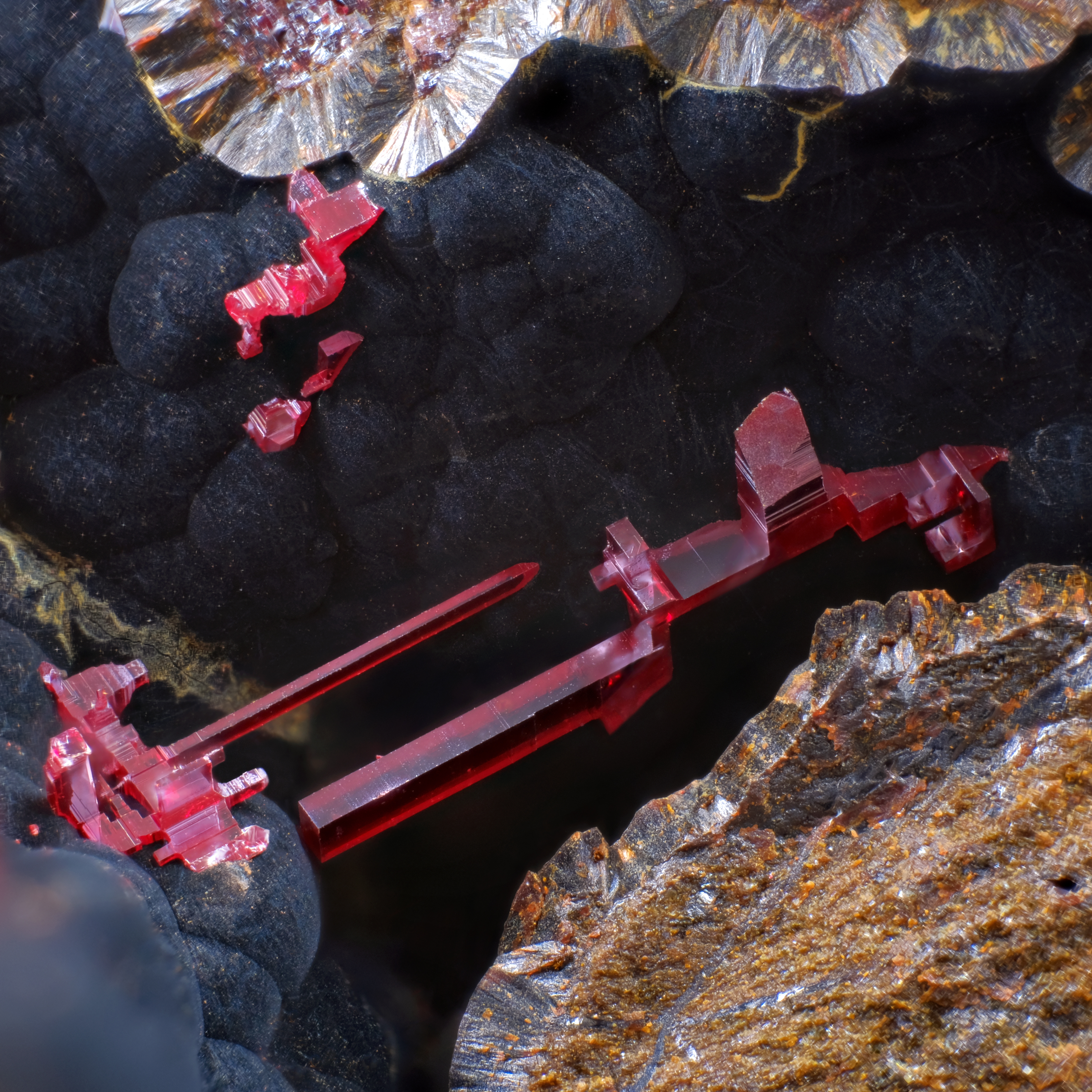
Cuprite Gemstone: Nneɛma, Nkyerɛase, Botae & Nea Ɛkeka Ho
 Cuprite yɛ kɔbere kɔkɔɔ a ɛwɔ wiase nyinaa. So cuprite yɛ aboɔden abo? Yep! Wɔde Cuprite nso di dwuma sɛ aboɔden abo wɔ agude ne nneɛma a wɔde siesie nneɛma mu.
Cuprite yɛ kɔbere kɔkɔɔ a ɛwɔ wiase nyinaa. So cuprite yɛ aboɔden abo? Yep! Wɔde Cuprite nso di dwuma sɛ aboɔden abo wɔ agude ne nneɛma a wɔde siesie nneɛma mu.
Ɔbo no kɔla betumi ayɛ te sɛ garnet anaa ruby na ne hyerɛn a ɛhyerɛn no boro daimond de so. Saa su ahorow yi ma cuprite yɛ ade a ɛho hia a wɔde ka nneɛma biara a wɔaboaboa ano ho.
Cuprite a ɛyɛ aboɔden abo nso ho yɛ na koraa, na ɛma wɔn a wɔboaboa ano anaa wɔn a wɔn ani gye ho no ani gye ho kɛse mpo.
Wopɛ sɛ wohwehwɛ cuprite aboɔden abo bi a wɔtɔn mu? Saa akwankyerɛ yi bɛkyerɛ wo biribiara a ɛsɛ sɛ wuhu fa cuprite ho, efi ne agyapade ne ne bo so kosi ayaresa tumi ne abakɔsɛm so.
 Mfonini no fi: Rob Lavinsky, iRocks.com – CC-BY-SA-3.0
Mfonini no fi: Rob Lavinsky, iRocks.com – CC-BY-SA-3.0
Dɛn Ne Kuprite Ɔbo?
Cuprite yɛ aboɔden abo a ɛsom bo fã bi , ɛmfa ho sɛ ɛwɔ kɔla a ɛyɛ ruby ne sparkle of diamond, aboɔden abo anan a ɛsom bo no mu abien (a safir ne emerald ka ho) no. Nokwarem no, abodin biako a wɔde frɛ cuprite ne “ruby copper” anaa “ruby copper ore.”
Sɛ́ ade a ne bo nyɛ den a wɔde besi ruby ananmu no, wobetumi de cuprite asi July awobo ananmu . Cuprite nso betumi ayɛ January awobo foforo esiane sɛnea ɛte sɛ garnet nti. Ebetumi nso asi ayeforohyia afe a ɛto so 2 afahyɛ aboɔden abo (garnet) anaa afe 40 afahyɛ aboɔden abo (ruby) a wɔde di dwuma wɔ amanne kwan so no ananmu.
Wɔ nsoromma mu hwɛ mu no, cuprite yɛ nsoromma mu hwɛ bo a wɔde kyerɛ asase so nsɛnkyerɛnne — Taurus, Virgo, ne Capricorn. Ɛne akontaahyɛde 2 a ɛwɔ akontaahyɛde mu nso hyia.
Wɔ aboɔden abo akyi no, dɛn na wɔde cuprite yɛ?
Ɛwom sɛ bere bi na ɛyɛ kɔbere fibea de, nanso nea ɛho hia sen biara a wɔde cuprite adi dwuma ne nea wɔde yɛ kɔla anaa kɔla de yɛ ahwehwɛ kɔkɔɔ.
Cuprite Nkyerɛkyerɛmu & Su ahorow
Nea edi kan no, so cuprite yɛ kɔbere? Wɔ ntease a ɛne sɛ ɛyɛ kɔbere aboɔden abo mu, yiw, nanso ɛnyɛ kɔbere nkutoo. Mmom no, ɛyɛ kɔbere oxide. Cuprite aduru no yɛ Cu2O.
Sɛ cuprite ba wie a, ebetumi ayɛ pseudomorph (asakra ayɛ aboɔden abo foforo nanso ne te sɛ ahwehwɛ koro no ara) abɛyɛ malachite. Malachite yɛ kɔbere carbonate hydroxide a ɛyɛ ahabammono a ne nsusuwii yɛ Cu2CO3(OH)2.
Ɔkwan titiriw biako a wɔfa so hu ne streak test. Sɛ wode nhwɛsode a wɔannoa ne streak plate di dwuma a, wubetumi aprapra ɔbo no fã bi a wontumi nhu denneennen de ahu kɔla powder a ɛde ba (ne streak). Cuprite streak ankasa bɛyɛ dade a ɛyɛ bruu-kɔkɔɔ.
Cuprite nso di kan koraa wɔ Mohs mineral hardness scale , a ɛkyerɛ sɛ mineral dodow no ara bɛtwetwe no. Esiane sɛ ɛyɛ dade nti, ɛyɛ den nso, enti ɛbɛyɛ te sɛ nea emu yɛ duru sen abo afoforo a ne kɛse yɛ pɛ.
Ɔkwan a cuprite fa so no betumi ayɛ octahedral, cubic, anaa dodecahedral, ɛwom sɛ nea etwa to no ne nea ɛntaa nsi de. Penetration twinning nso abu so, baabi a ahwehwɛ bi nyin na ɛpaapae kɔ akwan horow abien so, na ɛma ahwehwɛ “twin” ba. Nanso, ɛsono sɛnea mineral no te, na yɛbɛka ho asɛm pii akyi.
Mprempren de, cuprite mu mineral ahorow a aka ni:
Mohs denden : 3.5-4
Kɔla : Kɔkɔɔ, kɔkɔɔ tuntum, tuntum
Ahwehwɛ nhyehyɛe : Isometric/Cubic
Luster : Ɛnyɛ dade, adamantine, asase
Transparency : Ɛyɛ nea ɛda adi pefee kosi nea ɛnyɛ nea ɛda adi pefee
Nneɛma a ɛma nneɛma yɛ mmerɛw : 2.84-2.85
Nnipa dodow : 6.14-6.15; 6.00-6.07 (Namibiafo nneɛma) .
Cleavage : Ohia, 4-akwankyerɛ
Akisikuru : Conchoidal
Streak : Dade a ɛyɛ bruu-kɔkɔɔ
Luminescence : Biara nni hɔ
Pleochroism : Ɛba wɔ ɔkwan a ɛnteɛ so (efisɛ ahwehwɛ nni birefringence) .
Cuprite su a ɛyɛ ahwehwɛ no mu kakraa bi na ɛyɛ ɔbo no ahorow ahorow.
Cuprite ahorow ahorow
Cuprite afrafra anaa nea ɛsono no bi (ɛte sɛ nea wobetumi abu no sɛ ɛyɛ ahorow, nanso ɛda nsow araa ma ɛfata sɛ wɔto din ahorow) ne:
Burnite : Abotan a wɔde cuprite, azurite, ne ɛtɔ mmere bi a malachite na ɛyɛ
Tile Ore : Cuprite variant a ɛwɔ su kɛse ne birikisi kɔkɔɔ kɔla, a wɔtaa hu wɔ malachite nkyɛn
Chalcotrichite : Wɔsan frɛ no “plush copper ore,” cuprite soronko bi a ɛwɔ ahwehwɛ a ɛyɛ tratraa a ɛyɛ nhama anaasɛ aduru a wɔde petepete so a ɛte sɛ nhwi
Ebia Chalcotrichite ne ɔkwan a wonim no yiye sen biara. Edin no fi German kasa mu chalkotrichit , a wonya fii Hela nsɛmfua a wɔde gyina hɔ ma “kɔbere” ne “nwi” mu.
Ebia wubehu nnɔbae a ɛyɛ matted a ɛwɔ calcite ahwehwɛ atifi no.
 Mfonini no fi: Rob Lavinsky, iRocks.com – CC-BY-SA-3.0
Mfonini no fi: Rob Lavinsky, iRocks.com – CC-BY-SA-3.0
Cuprite Nkyerɛase & Abakɔsɛm
Cuprite yɛ ahiade atitiriw, aduannuru, ne awerɛhyem ho sɛnkyerɛnne. Wɔakyerɛ cuprite honhom mu ntease nso ase sɛ egyina hɔ ma ahoɔden, ahoɔden, ne nkannyan.
Wɔ metaphysical nneyɛe mu no, cuprite yɛ asase element no dea. Nkyerɛase ahorow fa eyi sɛ ɛkyerɛ sɛ cuprite ne Ɛna Asase ne shamanism wɔ abusuabɔ. Wɔ tete adwinni a ɛma ahoɔden kari pɛ a wɔfrɛ no Feng Shui mu no, asase so abo bata ahobammɔ, nyansa, ne abusua ho.
Abakɔsɛm
Edin “cuprite” no fi Latin kasa cuprum , a ɛkyerɛ “kɔbere” mu. Austriani aboɔden abo ho ɔbenfo Wilhelm Karl Ritter von Haidinger (anaasɛ Wilhelm Haidinger kɛkɛ) paw din no wɔ 1845 mu.
Ansa na Haidinger repaw din a ɛbata ho no, na kan din ahorow a wɔde frɛ cuprite no bi ne:
Ruberite a wɔfrɛ no ruberite
Octahedral Kɔbere / Octahedral Kɔbere Ore
Kɔbere Kɔkɔɔ / Kɔbere Kɔbere Kɔkɔɔ a Ɛyɛ Glassy
Kɔbere a Wɔde Oxydulated Ayɛ
Nsu mu aduru a wɔfrɛ no hydrocuprite
Nneɛma a wɔde di dwuma ma cuprite no kɔ akyiri mfe mpempem pii. Fam tutu ho kyerɛwtohɔ kyerɛ sɛ wɔde cuprite ama ahwehwɛ kɔla kɔkɔɔ, na ɛde ade a wɔfrɛ no ruby ahwehwɛ, fi 2,000 kosi 1,000 A.Y.B.
Sɛ yɛdan kɔ nnɛyi bere yi mu a, cuprite abɛyɛ nea ɛntaa nsi koraa. Nneɛma a ɛyɛ aboɔden abo a eye sen biara no fi Namibia wɔ 1970 mfe no mu.
 Mfonini no fi Masha Milshina | Creative Commons Attribution 4.0 Amanaman ntam tumi krataa
Mfonini no fi Masha Milshina | Creative Commons Attribution 4.0 Amanaman ntam tumi krataa
Cuprite Ayaresa Nneɛma
Kɔla ne ahoɔden a ɛwɔ aboɔden abo mu no betumi anya tumi a ɛwɔ sɛ ɔbo a ɛsa yare so nkɛntɛnso . Cuprite aboɔden abo yɛ kɔkɔɔ, na ɛkanyan mfasoɔ a ɛwɔ aboɔden aboɔ kɔkɔɔ so te sɛ nkannyan, ahoɔden, ne akɔnnɔ a ɛma obi nya nkɔsoɔ.
Cuprite dodow no ara nyɛ gem-quality na ebia ɛwɔ tuntum hue. Te sɛ aboɔden abo tuntum afoforo , saa ahwehwɛ yi ma wɔde ahofama kɛse ma honhom mu nneyɛe, nimdeɛ a ɛkorɔn, ne ahobammɔ fi tumi bɔne ho.
Nanso nipadua, nkate, ne chakra ayaresa su a ɛwɔ cuprite mu no nso ɛ?
Nipadua mu Ayaresa
Mfaso ahorow bi a wɔkyerɛ sɛ ɛwɔ cuprite so ne sɛ wɔbɛsa:
Asaabo a ɛnyɛ adwuma yiye
Akisikuru ho haw ahorow
Vertigo a ɛma obi ho kyere no
Kankyee yare
Awo ho nsɛm
Oxidative adwennwen
Te sɛ ne honhom fam ntease ne fekubɔ ahorow no, cuprite honam fam su ahorow di akɔneaba wɔ honam fam ahoɔden ne ahoɔden a ɛkɔ soro ho. Wogye di sɛ ɔbo no boa ma obi tra nkwa nna tenten ne nipadua mu akwahosan nyinaa.
Nkate mu Ayaresa
Wɔ nkate fam no, wɔka sɛ cuprite yɛ anwonwade ma amemene no. Wogye di sɛ ɛma woyɛ nhwehwɛmu, onyansafo, na wobɔ mmɔden kɛse.
Cuprite ahwehwɛ no nso betumi ayi awerɛhow afi hɔ, ama wo ho adwo wo wɔ nkate fam ahokyere mu, na aboa wo ma woadi dadwen a ntease nnim so denam mmoa ne ahobammɔ ho nkate a wode bɛma wo honhom no so.
Chakra Ayaresa
Chakra ahorow a ɛkari pɛ yɛ tete adwinni a wɔde hu sɛnkyerɛnne bɔne, hu chakra (ahoɔden mfinimfini) a sɛnkyerɛnne ahorow no bata ho, na wobue chakra no de siesie sɛnkyerɛnne ahorow no.
Cuprite yɛ chakra ɔbo ma ntini (anaasɛ nnyinaso) chakra, a ɛhwɛ ahiade atitiriw te sɛ ahobammɔ, fam, ne nkitahodi so. Sɛ wɔasiw ano a, wote asiane nka bere nyinaa anaasɛ ebia wobɛte nka mpo sɛ woretwe wo ho afi nokwasɛm ho. Sɛ wode cuprite di dwuma a, wubetumi abue chakra no de ayɛ wo ho asase na woate nka sɛ wo ne abusua anaa w’adɔfo wɔ abusuabɔ.
Wɔ nneɛma afã a ɛyɛ aboɔden abo no, ɛbɛyɛ dɛn na cuprite nya abasobɔde?
 Mfonini a ɛwɔ atifi hɔ no: Azurite cabochon a wɔde cuprite kɔkɔɔ aka ho
Mfonini a ɛwɔ atifi hɔ no: Azurite cabochon a wɔde cuprite kɔkɔɔ aka ho
Cuprite Aboɔden abo Nneɛma a Ɛwɔ Hɔ
Cuprite bo gyina baabi a ɔbo ankorankoro biara hwe ase a egyina kɔla, nea wɔatwa, ne ne kɛse so.
Ahosuo
Akyinnye biara nni ho sɛ kɔla a eye sen biara ne signature cuprite ruby red hue no. Ɛnyɛ sɛ saa ɛnne yi yɛ fɛ nko, na mmom ɛntaa nsi sɛ wubehu cuprites a ɛyɛ aboɔden abo a wɔde kɔla yi ayɛ.
Nea ɛde cuprite kɔla ba ne kɔbere a ɛwɔ mu — ade koro no ara a ɛde azurite ne malachite kɔla ba.
Nanso, cuprite nso betumi ayɛ kɔkɔɔ ahorow na ɛbɛn tuntum mpo. Saa kɔla ahorow yi som bo kɛse.
Twa
Cuprite a wobɛtwitwa ayɛ no afã horow no ye sen biara ma ne kɔla a ɛyɛ frɔmfrɔm, ne refractive index a ɛkorɔn, dade a ɛhyerɛn, ne ne hyerɛn a ɛyɛ nwonwa a ɛbɛda adi. Cuprite a wɔatwitwa no yiye bɛyɛ nea ɛsom bo kɛse. Ɛno akyi no, ɔfã a wɔatwa no yiye no bɛtaa akyerɛ ɔbo a ɛyɛ kusuu na ne kɔla tuntum a ne bo sua.
Nea ɛyɛ awerɛhow no, cuprite a ɛyɛ mmerɛw no ma agude a wɔde bedi dwuma no nyɛ nea nyansa wom mma afã horow a wobetumi apaw. Nanso, nhwiren ne cabochons da so ara yɛ cuprite agude a ɛyɛ fɛ a wobetumi apaw!
Mpɛn pii no, wubehu cuprite sɛ wɔtɔn bere a wɔde afra sɛ nea wɔde ka abo afoforo ho, cuprite azurite anaa cuprite chrysocolla. Mpɛn pii no, wohu abo afoforo yi sɛ nneɛma a wɔde ka cuprite ho.
Kɛseɛ
Cuprite a ɛho yɛ na no fã bi fi nokwasɛm a ɛyɛ sɛ n’ahwehwɛ dodow no ara yɛ nketenkete dodo sɛ aboɔden abo ara kwa no mu. Nanso, Namibia akorae biako (a ɛwɔ Onganja) ama ahwehwɛ a ɛte sɛ aboɔden abo a ɛsõ sɛnea ɛbɛyɛ a wobetumi ayɛ faceting, na ama cuprite a efi saa mmeae yi som bo.
Sɛ yɛreka ne fibea ho asɛm a, ɔkwan bɛn so na cuprite yɛ? Na ɛhe na efi?
 Mfonini no fi Masha Milshina | Creative Commons Attribution 4.0 Amanaman ntam tumi krataa
Mfonini no fi Masha Milshina | Creative Commons Attribution 4.0 Amanaman ntam tumi krataa
Cuprite Formation & Nneɛma a Wɔde Yɛ Adwuma
Cuprite taa ba bere a kɔbere a ɛwɔ hɔ no asɛe wim tebea no. Asase ase nsu ne kɔbere aboɔden abo a ɛwɔ adekorabea hɔ, aboɔden abo titiriw no yɛ adwuma, na ɛma ɛsakra yɛ aboɔden abo a ɛto so abien. Saa aboɔden abo a ɛto so abien yi mu biako ne cuprite.
Mpɛn pii no wubehu cuprite wɔ mmeae a oxidized wɔ lodes a kɔbere pii wom (ntini a ɛda abotan ntam). Ɛtaa yɛ kɔbere, azurite, malachite, ne limonite a ɛwɔ hɔ no nkyɛn.
Mmeae a Wɔtu Tuo
Ɛhe na wohu cuprite ɔbo? culprite crystals a ɛsõ sen biara a ɛte sɛ aboɔden abo no fi Namibia. Nneɛma foforo a wonya fi cuprite mu ne:
Afrika
Australia
Bolivia
Chile
England
France
Japan
Mongolia (Altai Mmepɔw) .
Russia (Ural Mmepɔw) .
Sardinia na ɛwɔ hɔ
U.S.A. (Arizona) .
Nokwarem no, asɛmmisa a ɛho hia sen biara ma adetɔfo dodow no ara ne sɛ: cuprite ɔbo bo yɛ ahe?

Cuprite Abo Bo & Ne Bo
Cuprite bo a wɔbɔ ma aboɔden abo a ɛwɔ afã horow no yɛ $40-$200 wɔ carat biara mu.
Cabochon dodow no ara yɛ azurite cuprite, malachite cuprite, anaa chrysocolla cuprite. Saa abo yi bo bɛyɛ dɔla 50 kosi 200 biara wɔ nea wɔtɔn no kɛse mu. Ɛtɔ mmere bi a wɔtɔn chrysocolla ne cuprite afrafra sɛ “Sonora Sunrise” anaa “Sonora Sunset.”
Cuprite rough wɔ bo a ɛtrɛw kɛse, efi ase bɛyɛ $5 kosi $10 na ɛkɔ soro kodu $200.
Cuprite Hwɛ ne Nsiesiei
Ansa na yɛbɛka aboɔden abo a wɔhwɛ so ho asɛm , momma yenni kan nsusuw sɛnea wobɛhwɛ w’ankasa akwahosan ho. Esiane kɔbere a ɛwɔ mu nti, ebia wubesusuw sɛ: so cuprite yɛ awuduru? Ebetumi ayɛ saa. Cuprite mfutuma anaa nhama yɛ nea asiane wom sɛ wobɛhome, na ebetumi ama obi afe na mpo asaabo anaa mmerɛbo asɛe bere a wɔde ahyɛ mu mpɛn pii no.
Nanso, cuprite mfutuma yɛ ade titiriw a ɛhaw wɔn a wotwitwa aboɔden abo anaa obiara a ɔdi nneɛma a ɛyɛ den ho dwuma. Nhwɛsode a wɔayɛ no fɛfɛɛfɛ no yɛ nea asiane biara nni ho sɛ wobedi ho dwuma.
Wɔ aboɔden abo hwɛ so no, ade a edi kan ne sɛ wobɛpaw cuprite a ɛfata. Sɛnea ɛyɛ mmerɛw no ma ɛyɛ mmerɛw, enti yɛhyɛ nyansa sɛ paw pendants anaa asomuade a ɛnyɛ den pii sen sɛ wobɛpaw cuprite ring.
Ɛmfa ho nea wobɛpaw no, paw agude a ɛwɔ nhyehyɛe a ɛbɔ wo ho ban na ama woanya ahobammɔ a eye sen biara afi nsensanee anaa abubu ho.
Wubetumi de samina a ɛnyɛ den ne nsu a ɛyɛ hyew ahohoro cuprite a wɔayɛ no fɛfɛɛfɛ anaasɛ wɔayɛ no anim. Sɛ wohohoro samina a ɛboro so biara a, fa ntama a ɛyɛ mmerɛw a mfutuma nnim a microfiber wom di dwuma na ama ɔbo no ayow. Mfa nneɛma a emu yɛ den a wɔde siesie fie, nnuru, anaa mfiri/ultrasonic a wɔde tew nneɛma ho nni dwuma.
Ɛyɛ papa sɛ wode cuprite abo ne agude besie baabi a ɛhɔ yɛ sum na wɔato mu a ɛne aboɔden abo afoforo ntam kwan ware.
Fa Cuprite Ɔbo Dua Wo Nneɛma a Woaboaboa Ano!
Ebia wɔn a wɔboaboa aboɔden abo ano no nim cuprite ho nsɛm pii sen nea ɔtɔ no, nanso ɛno ma ɔbo no yɛ nea wontumi nhu na ɛyɛ anigye. Ne hyerɛn a ɛhyerɛn a wɔde dade hyerɛn ne nkonyaayi kɔkɔɔ kɔla ahorow aka ho no yɛ pɛpɛɛpɛ ma wo honhom, ne honhom mu ahoɔden, a ɛbɛkɔ so ayɛ hyew na atra ase!
搜尋Gemstone Encyclopedia
相關拍賣
相關文章
Momma yɛnkyerɛkyerɛ sɛnea wɔtɔ aboɔden abo wɔ intanɛt so. Yɛwɔ aboɔden aboɔ a ɛso sen biara wɔ intanɛt so na ɛbɛtumi ayɛ den kakra wɔ mfitiaseɛ no. Ma yɛmfa afotu bi a mfaso wɔ so mmoa wo.
3rd Oct 2018
W’aboɔden abo a wobɛhwɛ so no boa ma ɛyɛ fɛ wɔ wo nkwa nna nyinaa mu. Yɛbɛka nneɛma te sɛ denden ne ayaresa ho asɛm, ne anammɔn a ɛfa sɛnea wobɛhohoro wo aboɔden abo na wode asie dwoodwoo ho.
9th May 2018
So woasusuw sɛnea wɔyɛ Ruby aboɔden abo ho pɛn? Ayaresa ahorow pii wɔ gua so na yɛbɛboa ma yɛakyerɛkyerɛ mu
9th May 2018
最新的文章
Chrysanthemum nhwiren abo yɛ abɔde mu anwonwade a ɛwɔ calcite, celestite, anaa andalusite nhwiren fitaa bi a wɔde asisi limestone tuntum anaa atɛkyɛ abo so.
13th Jan 2026
Rainbow lattice sunstone yɛ feldspar ahorow a ɛwɔ optical nsunsuanso abiɛsa fɛfɛ a efi nneɛma ahorow a wɔde ka ho a ɛwɔ hɔ no mu ba. Ɛyɛ ogya kɔla display ne lattice nsusuwso ma ɛyɛ coletor abohene a wɔntaa nhu!
12th Jan 2026
Thulite yɛ Norwayfo aboɔden abo a wɔntaa nhu a ɛda rosy hue a ɛyɛ hyew a efi zoisite mineral abusua a wɔtaa de di dwuma wɔ agude tebea ne pendants mu adi.
6th Jan 2026
文章類別
How To's is where you will find helpful articles from gem Rock Auctions on how to cut gemstones, select gemstones and buy gemstones.
9文章




